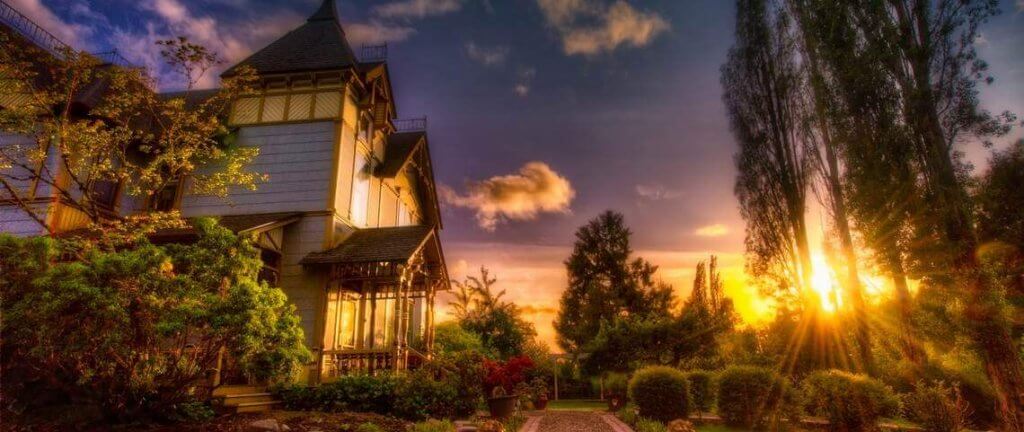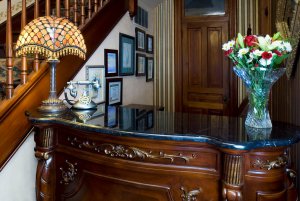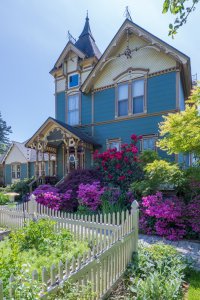History of an iconic Olympia Mansion
William G. White, a carpenter and lumberman, and his wife, Amanda, built this 17-room home in the flush of optimism that followed Washington statehood in 1889. They chose an upright variation of the Victorian / Queen Anne Revival style. The large frame residence is basically rectangular in plan with a hipped roof, although gabled roof lines intersecting the main form tend to confuse the appearance of the roof. The most dominant feature is the square tower, scaled a full three stories and emerging from the northeast corner of the building; it is capped by a steep pyramidal roof with a finial.

The exterior is most notable for the tower and its ornate decoration. Turned spindles, cross pieces, balusters and posts adorn the porches and gables. Angled and vertical boarding enhance gable ends and tower. In addition to the scrolled brackets supporting each horizontal eave, the barge-boards themselves are adorned by very delicate carved designs. Decorative dentils underpin all of the eaves as well as the Italianate square bay windows on either side of the house on the main floor. The house has a rather ordinary fenestration, but the decorative surrounds on the first story extend below the window opening and into a stylized water table, delineated by vertical boarding and small cornice, continuous around the base of the house.

When this large house was built in 1887 it was located in Swantown, a densely wooded and remote town and overlooking the Swantown Slough, a narrow tidal inlet that separated it from the town of Olympia. It was not until 1911, when a massive dredging project expanded Olympia’s usable harbor, that the Swantown Slough was filled in with mud scooped from the floor of Budd Inlet. Forty new city blocks were also created on the northern edge of downtown with two million cubic yards of fill dredged up from the shallow bay.
Mr. White had bad luck in the house both because of the financial hard times of 1893 shortly after the completion of the house. The Oregon Mortgage Company foreclosed upon the house in 1895 and since that time has had a variety of owners, both private citizens and banking institutions. Although no one owner stands out at a historical or prominent figure, several accounts about the house mirror Olympia’s history. It is said that the house was built partly with money loaned by Governor Elisha P. Ferry in 1893. A former resident of the house claims it was one of the town’s most handsome homes around the turn of the century when Theodore L Brown owned it. Foreclosed for $2,000 in 1895 it was being sold for $5,500 by 1910. During the 1930′s it was divided into apartments and its no longer used ballroom on the third floor was dismantled.

The original house remains largely as built. The gazebo was added in the 70′s, as was the metal railing on the roof. The main floor of the house is still mainly intact. In addition to the front and back parlors, on the main floor there is a bedroom or borning room adjacent to the bathroom and kitchen, which is a customary feature of the 19th century houses. This room is now a part of the innkeepers’ apartment, which was added in 2000, and now serves as the office for the inn. The pantry and kitchen have been altered but the dining room exhibits some lovely spindle-work, a favorite embellishment of the day. The side porch opens onto the dining room. All of the interior doorways have transoms to allow light into the rooms. The interior woodwork is cedar and follows the medallion design of the exterior moldings. Several of the walls put in place when it was divided into apartments have been removed in accordance with the original construction.
The house is a representative example of the kind of architecture and architectural embellishment that was common in Olympia around the turn of the century. Most other examples of homes of that era have either been torn down or altered to a great extent.

Around 2015 EV charging was added to the parking area. Both a Tesla and Universal station were added, providing overnight guests the ability to charge their electric and hybrid vehicles.
In 2017 the Inn was almost doubled in size by the addition of the ballroom, suite and garage. The ballroom functions as an event space and is where the Espresso Bar is located. It operates under the name, The Grand Victorian Ballroom. The suite was named the Puget Suite, after the Puget Sound and following the naming theme of the existing rooms.
In February 2021 solar power was added to the Inn. Luckily the rear facing roof is the best placement for the panels, as they do not affect the street-view of the house. These panels along with many other energy efficient upgrades make this grand old structure more energy efficient than one might imagine.
The Inn and grounds are a constant work in progress. From the Vegetable and Berry Gardens in the front yard, to future plans for a bocce court and fire pit area.
